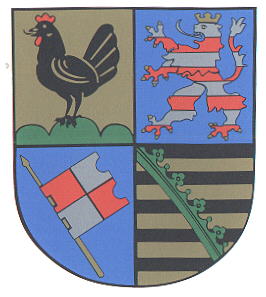Schmalkalden-Meiningen: Difference between revisions
Knorrepoes (talk | contribs) m (Text replacement - ". ===Origin/meaning===" to ". |- |'''English''' | {{blazon wanted}} |} ===Origin/meaning===") |
Knorrepoes (talk | contribs) m (Text replacement - "{{de}} '''" to "{{de}} '''") |
||
| Line 1: | Line 1: | ||
{{de}} | {{de}} | ||
'''SCHMALKALDEN-MEININGEN (SM)''' | '''SCHMALKALDEN-MEININGEN (SM)''' | ||
Revision as of 12:12, 16 July 2022
This page is part of the German heraldry portal Deutsche Wappensammlung |
Heraldry of the World |
|
German heraldry:
|
Selected collector's items from Germany:
|
SCHMALKALDEN-MEININGEN (SM)
State : Thüringen
Additions : 1994 Meiningen, Schmalkalden, Suhl-Land
| German | Geviert; 1 in Gold auf einem grünen Dreiberg eine schwarze Henne mit rotem Kamm und roten Lappen; 2 in Blau ein siebenmal von Silber über Rot geteilter, golden gekrönter und bewehrter Löwe; 3 in Blau eine schrägrechte goldene Lanze mit einer rot-silbern gevierten Fahne, deren linker Rand in jedem Feld eine halbkreisförmige Einbuchtung zeigt; 4 neunmal von Schwarz über Gold geteilt und mit einem schrägrechten grünen Rautenkranz belegt. |
| English | No blazon/translation known. Please click here to send your (heraldic !) blazon or translation |
Origin/meaning
The arms were officially granted on July 15, 1995.
The arms are made up of parts of the arms of the former counties Schmalkalden, Meiningen and Suhl-Land.
The rooster, derived from the arms of the counts of Henneberg, was present in all three former arms. The second quarter is the lion of Hessen, and symbolises the fact that the area was owned by the counts of Hessen from 1360-1866. The banner in the third quarter is taken from the arms of Meiningen and indicates the fact that Meiningen was owned by the Prince-Bishops of Würzburg. The arms of Saxony in the fourth quarter are a reminder of the Duchy Sachsen-Meiningen from 1680-1918.
Contact and Support
Partners:
Your logo here ?
Contact us
© since 1995, Heraldry of the World, Ralf Hartemink 
Index of the site
Literature : Linder and Olzog, 1996.












